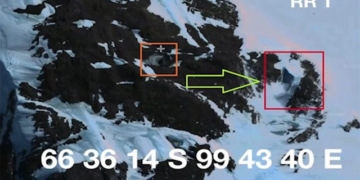If you plug the outlet of an air pump with your finger, you can still push its piston down. The reason: Gases are relatively easy to compress—unlike liquids. If the pump contained water instead of air, it would essentially be impossible to move the piston, even with the greatest effort.
Gases typically consist of atoms or molecules swirling around more or less in space. It’s quite similar to light: Its smallest building blocks are photons, which, in some ways, behave like particles. These photons can also be considered a gas; however, a photon behaves somewhat unusually: You can compress it under certain conditions with hardly any effort. At least, that’s what theory predicts.

Photons in a Mirror Box
Researchers from the Institute of Applied Physics (IAP) at the University of Bonn have demonstrated this effect in experiments.
Dr. Julian Schmitt of IAP—lead investigator in Professor Dr. Martin Weitz’s team—explains: “To achieve this, we stored light particles in a small box made of mirrors. The more photons we put in there, the denser the photon gas becomes.”
The general rule is: The denser the gas, the harder it is to compress. This is also the case with the plugged air pump—initially, the piston can be pushed down very easily, but at some point, it becomes difficult to move, even with significant force. The initial Bonn experiments were similar: The more photons they placed in the mirror box, the harder it became to compress the gas.
However, the behavior changes abruptly at a certain point: As soon as the photon gas exceeds a specific density, it can suddenly be compressed with hardly any resistance. “This effect is a result of the rules of quantum mechanics“, Schmitt explains, who is also an associated member of the Excellence Cluster “Matter and Light for Quantum Computing” and project leader at the Transregional Collaborative Research Center 185. The reason: Light particles exhibit “fuzziness”—simply put, their positions are somewhat blurred. When they come very close together at high density, the photons begin to overlap. Physicists then also refer to the “quantum degeneracy” of the gas. Compressing such a degenerate quantum gas becomes much easier.
Self-Organizing Photons
If the overlap is strong enough, the light particles merge to form a type of super photon, a Bose-Einstein condensate. Simply put, this process can be compared to the freezing of water: In liquid state, water molecules are disordered; then, at the freezing point, the first ice crystals form, eventually merging into an extended, highly ordered layer of ice. “Order islands” also form just before the Bose-Einstein condensate is created, and they grow larger as more photons are added.
The condensate is only formed when these islands grow large enough for order to extend throughout the entire mirror box containing the photons. This can be compared to a lake where independent ice floes eventually come together to form a uniform surface. Naturally, this requires a significantly larger number of light particles in an expanded box compared to a small box. “We were able to demonstrate this relationship in our experiments”, Schmitt points out.
To create a type of gas with a varying number of particles and a clearly defined temperature, the researchers used a “thermal reservoir”: “We introduced molecules into the mirror box that could absorb photons”, Schmitt explains. “Then, they emit new photons with an average temperature equal to that of the molecules—in our case, just below 300 Kelvin, which is room temperature.”
The researchers also had to overcome another obstacle: Photon gases often do not have a uniform density—in some places, there are many more particles than in others. This is due to the shape of the trap they are typically contained in. “We took a different approach in our experiments”, Erik Busley, the first author of the publication, states. “We captured photons in a flat-bottomed mirror box that we created using microstructuring techniques. This allowed us to create a uniform quantum gas of photons for the first time.”
In the future, the enhanced quantum compressibility of the gas will enable the study of new sensors capable of measuring extremely small forces. Besides the technological prospects, the results are also of great interest for fundamental research.




















































